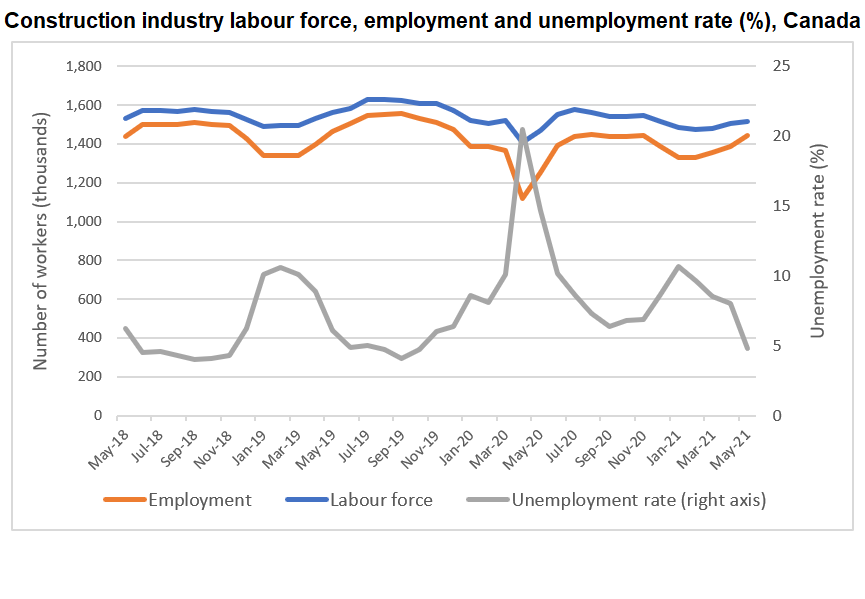Construction continues to push through the third wave of the COVID-19 pandemic.
Although public-safety measures remained in place across many provinces, May’s unadjusted labour force data for the construction sector shows a fourth consecutive month in which employment has risen.
The industry added 57,000 workers (4%) in May, which builds on the 31,000 workers added in April. May’s employment numbers are up by 193,600 (+16%) year over year. However, even with these impressive gains, industry employment remains more than 35,000 workers below May 2019.

Statistics Canada collected data for its most recent Labour Force Survey during the week of May 9 to 15. At the time, several provinces had tightened public-health measures to reduce the spread of the COVID-19 virus and its variants. Ontario, Alberta, Manitoba, and Nova Scotia were among those to limit public activities. In contrast, New Brunswick and Quebec eased some of their respective restrictions, moving those economies more firmly into recovery.
More positive signs across construction
Key metrics show that construction is operating at a much higher capacity this spring than it was a year ago.
The month-over-month industry unemployment rate, for example, was nearly cut in half, decreasing nationally to 4.8% in May, down from the 8% recorded in April. The unemployment rate remains 10 percentage points below April 2020 levels and 1.4 points below 2019 levels.
National total hours worked, meanwhile, were 36.8% higher in May 2021 than they were in May 2020, but remain slightly (-2%) below pre-COVID levels in May 2019. All provinces but two – Prince Edward Island and New Brunswick – recorded significant year-over-year gains in hours worked. At 65.8%, Newfoundland and Labrador recorded the largest increase over the year.
Despite the annual gains, national hours worked remained relatively unchanged from April levels. Newfoundland and Labrador (+56.7%), New Brunswick (+24.7%), and Manitoba (+13.1%) reported notable gains over the month, but the remaining provinces reported more modest increases in hours worked (<10%).
Workers are also returning to the industry. Construction’s labour force rose by 50,200 workers (+3.4%) compared to May 2020. The industry labour force now stands at 1,514,200. Quebec recorded the largest year-over-year labour force increase, with the province gaining 35,000 workers (+13%). Several provinces, including Prince Edward Island (-21.8%), New Brunswick (-9.1%), Newfoundland and Labrador (-5.5%), and British Columbia (-1.6%) reported declines in their respective labour forces.
Additionally, most provinces saw industry employment increase in May. Newfoundland and Labrador, for example, saw the largest percentage increase at 31.9%, while New Brunswick reported a gain of 18.4%. All other provinces reported employment increases, except for Prince Edward Island and Saskatchewan, where employment remained unchanged. These two provinces were the only ones to see an employment decline compared with May 2020, falling 17.7% and 3.9% respectively.

